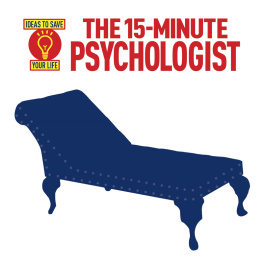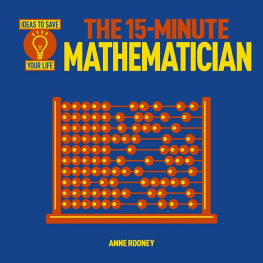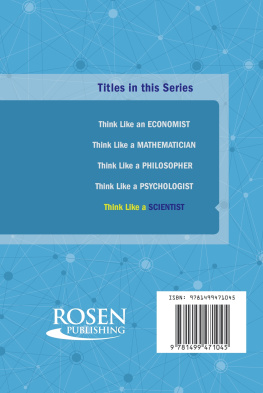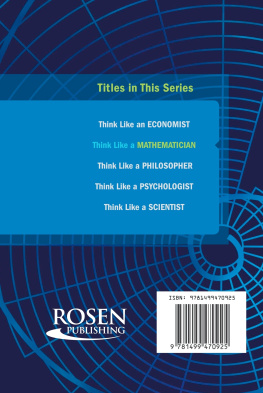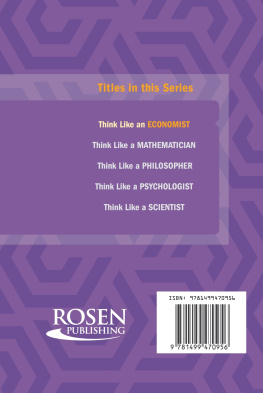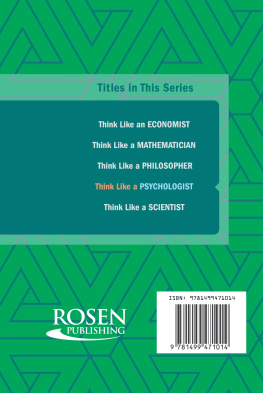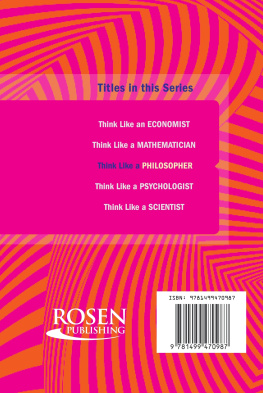Anne Rooney - The 15-Minute Psychologist
Here you can read online Anne Rooney - The 15-Minute Psychologist full text of the book (entire story) in english for free. Download pdf and epub, get meaning, cover and reviews about this ebook. publisher: Arcturus Digital, genre: Politics. Description of the work, (preface) as well as reviews are available. Best literature library LitArk.com created for fans of good reading and offers a wide selection of genres:
Romance novel
Science fiction
Adventure
Detective
Science
History
Home and family
Prose
Art
Politics
Computer
Non-fiction
Religion
Business
Children
Humor
Choose a favorite category and find really read worthwhile books. Enjoy immersion in the world of imagination, feel the emotions of the characters or learn something new for yourself, make an fascinating discovery.
- Book:The 15-Minute Psychologist
- Author:
- Publisher:Arcturus Digital
- Genre:
- Rating:4 / 5
- Favourites:Add to favourites
- Your mark:
- 80
- 1
- 2
- 3
- 4
- 5
The 15-Minute Psychologist: summary, description and annotation
We offer to read an annotation, description, summary or preface (depends on what the author of the book "The 15-Minute Psychologist" wrote himself). If you haven't found the necessary information about the book — write in the comments, we will try to find it.
The 15-Minute Psychologist — read online for free the complete book (whole text) full work
Below is the text of the book, divided by pages. System saving the place of the last page read, allows you to conveniently read the book "The 15-Minute Psychologist" online for free, without having to search again every time where you left off. Put a bookmark, and you can go to the page where you finished reading at any time.
Font size:
Interval:
Bookmark:
Chapter 1
What can we learn from a brain?

We cant watch the brain working like we can watch a heart pumping.
Psychology is the study of what goes on in the brain thinking, learning, personality, dreams, desires, character formation, behaviour determination, and disorders of all of those. But unlike the study of what goes on in, say, the heart, there is no mechanical process to observe directly. So scientists have had to find some ingenious ways of monitoring our thought processes.
Viewing our thoughts
In the early days of psychology, the only way of looking at a brain directly was once its owner had died. All psychological study had to be by experimenting with, observing and questioning live brain-users. While all those techniques remain extremely useful today, we now have ways of viewing the living brain while its doing its stuff. But viewing the brain raises as many questions as it answers. Knowing about the biology of the brain only takes us so far. We can see that it is doing something, but we still cant see quite what it is doing, or how. We can see neurons firing as someone thinks, but cant see what they are thinking, or why they had that thought, or how they will remember (or forget) it.
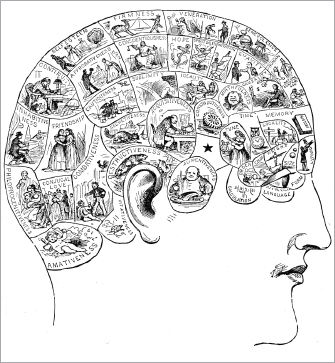
NEUROSCIENCE THE BASICS
The brain is made up of lots of cells called neurons (nerve cells), which are responsible for producing neural activity. Lots is around 86 billion. Neural activity includes receiving messages from the receptors in the sensory organs located in different parts of the body and transmitting messages to activate the muscles, for example, in other parts of the body. Some actions are conscious, such as raising your arm; some are unconscious, such as increasing heart beat.
Different parts of the brain are responsible for different types of neural activity. Information from the eyes is transmitted to the visual cortex at the back of the brain and processed to produce the images we see in the mind. Emotions, on the other hand, are processed in the amygdalae, two small structures located deep within the brain.
Size matters
| ANIMAL | NEURONS |
| Fruit fly | 100,000 |
| Mouse | 75,000,000 |
| Baboon | 14,000,000,000 |
| Cockroach | 1,000,000 |
| Cat | 1,000,000,000 |
| Human | 86,000,000,000 |
What goes where?
For millennia, the only way to discover which parts of the brain were used for different functions was to observe people who had suffered head injury and note how that had affected their mental or physical abilities, mood or behaviour. The changes resulting from the head injury were a good indication that different parts of the brain were responsible for different functions (emotions, cognition, personality and so on). Post-mortem examination revealed brain damage that might be related to changes or impaired function noticed in the person when they were alive. To acquire meaningful insights into the workings of the brain, scientists needed lots of brains to examine and sophisticated scientific equipment to do it with. So the brain was pretty much a closed book until the 20th century. Its not a very open book even now.
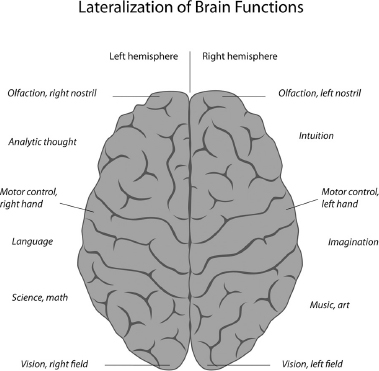

This diagram shows which areas of the brain correspond to the sensory input from different parts of the body. The relative size of the different body parts indicates how much of the brain is involved in processing the signals it receives, hence the hand is shown much larger than the foot.
The unfortunate Phineas Gage
The idea that specific parts of the brain might be responsible for different functions originated with the medical case of a railroad construction foreman called Phineas Gage. On 13 September 1848, Gage was seriously injured when a metal tamping iron a long, pointed rod weighing six kilograms was accidentally fired through his head. It entered through the cheek and left through the top of his head, taking fragments of his brain with it. He lost a bit more brain when he vomited, and about half a teacup full of brain fell on the floor, according to the doctor who attended him. The main damage was caused to one of the frontal lobes of his brain.
Although his friends had a coffin ready and waiting for him, remarkably, Gage (right) lived. However, his personality changed considerably for a long period. Instead of the polite and friendly man he had been before, he became difficult and antisocial though not the terrible character that legend suggests. His social ineptitude improved with time, and he ended his days working as a stagecoach driver in Chile. Its possible that the routine of his new life helped in his rehabilitation, as structured activity is found to be helpful in the treatment of many patients suffering damage to the frontal lobes.
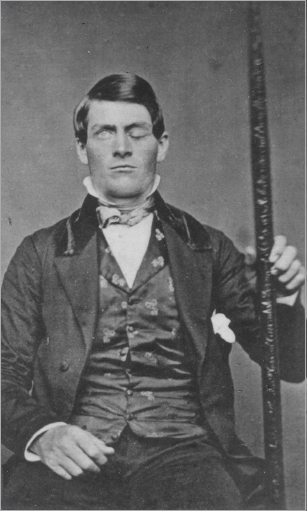
In two minds
The brain comprises two halves, or hemispheres. Each hemisphere contains the same structures and there is communication between the two via a thick bundle of nerve fibres called the corpus callosum. How the two hemispheres work together was explained by Roger W. Sperry, a neuropsychologist who treated patients with severe epilepsy by severing the corpus callosum. It sounds drastic, and it was, but it did cure their epilepsy. After he cut the connection between the two hemispheres, the right hand literally did not know what the left hand was doing.
At first the surgery appeared to have little impact on the patients apart from relieving their epilepsy. But investigation of Sperrys split-brain patients soon revealed that there had been major changes. In the process, Sperry gained new insights into how the two halves of the brain normally work together.
Sperry found that if he presented a picture to the right visual field (processed by the left side of the brain), the patient could name the object in speech or writing, but if it was presented to the left visual field they could not.
They could, though, identify the object by pointing. From this, Sperry concluded that language is processed in the left side of the brain.
[Each hemisphere is] indeed a conscious system in its own right, perceiving, thinking, remembering, reasoning, willing, and emoting, all at a characteristically human level, and both the left and the right hemisphere may be conscious simultaneously in different, even in mutually conflicting, mental experiences that run along in parallel.
Roger Wolcott Sperry, 1974
He found, too, that objects shown to the left side of the brain can only be recognized by that side. If he displayed different symbols in the right and left visual fields and then asked the person to draw what they saw, they only drew the symbol shown in the left visual field. If he then asked them what they had drawn (not seen), they described the symbol in the right visual field. Objects originally viewed in the left visual field were recognized if viewed again in the left, but not if then viewed in the right visual field.
Font size:
Interval:
Bookmark:
Similar books «The 15-Minute Psychologist»
Look at similar books to The 15-Minute Psychologist. We have selected literature similar in name and meaning in the hope of providing readers with more options to find new, interesting, not yet read works.
Discussion, reviews of the book The 15-Minute Psychologist and just readers' own opinions. Leave your comments, write what you think about the work, its meaning or the main characters. Specify what exactly you liked and what you didn't like, and why you think so.

